METRO BEIJING / METRO BEIJING
Su Shishu: a simple and humble artist
The celebrated calligrapher describes how dedication and passion have enriched his long-lasting artistic life
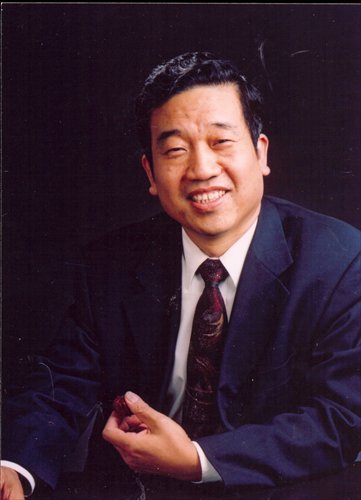
Su Shishu remains modest even though he has gained widespread fame. Photo: Courtesy of Su Shishu
Su Shishu is best known as a celebrated Chinese calligrapher and the vice president of the China Calligraphers Association - but he's more than just an artist.Over the years, Su has worked as an editor at the Cultural Relics Press and received China's highest national award, the Taofen Award, for editors; he's also organized many social activities such as seminars on Chinese calligraphy and engraving, as well as calligraphy and engraving competitions; he is a public figure who's taken part in many international cultural and art exchanges; and he writes books and textbooks on calligraphy, in addition to composing his own poetry.
Su has become such a respected figure over the years that those around him call him "master" - still, though, he remains modest. "After all, I am only an ordinary scholar," he often says.
It's rare for a man to maintain humility amid so many honors, titles and compliments, but Su has done so. It's only one more reason to memorialize his life, work and history.
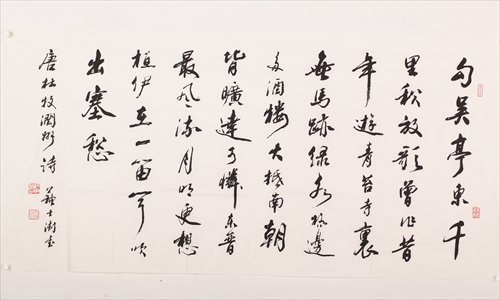
A poem by Tang Dynasty (618-907) writer Du Mu
A good student from childhoodSu was born in 1949 in Beijing to a scholar-gentry family. Even as a child, he stood out from the other children, devoting his time, not to play, but to the ancient books that were handed down from his ancestors. He was attracted, he said, by their ancient seals. This interest would serve as the seeds of what would become his future career and life's pursuit.
Su's parents noticed his interest in and talent for art early on, and soon began teaching him about traditional Chinese culture and art. Calligraphy quickly became Su's favorite, and over the years he developed his skills in calligraphy and engraving. However, his hobbies did not delay his schoolwork. Su was an excellent student from primary school to high school.
When Su was 13, he was accepted as a student by famous calligrapher and engraver Liu Boqin. He cherished every day that he spent studying with Liu, and saw rapid progress.
Su's study was impeded by the Cultural Revolution (1966-76), but he never gave up learning and nothing could suppress his desire to make art.
By the end of the Cultural Revolution, he was making secret visits to Liu's home to continue his studies. Most of Liu's books and tools were destroyed in the turbulence, but he managed to hide some of them. In the end, the disaster brought the teacher and the student even closer. Su's diligence paid off, putting him head-and-shoulders above many of his peers.
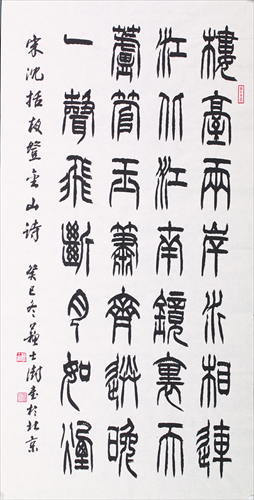
Poetry by Song Dynasty (960-1279) writer Shen Kuo
An editor of artWhen society went back normal in the 1980s, Su quickly distinguished himself with his unique perspective.
Around that time, Su met famed calligrapher Qi Gong, and soon the two became quite close. Having learned much from his master, Su's talent was noticed by many art institutions. He was soon overwhelmed by job offers; unable to choose, he asked Qi and Liu for advice. They both said the same thing, which was that he should go to the Cultural Relics Press and work as an editor.
Su started out as an editor, but after years of hard work, he rose to become director of the press. Most crucial for Su in this capacity was the close relationship he developed with various books. He read books, wrote books, edited books and commented on books, all of which enriched his art skills.
Though he's widely hailed as a scholar, Su maintains that the greatest pity of his life is that he never attended university. However he has nothing to regret, because throughout his life he's had the chance to learn from some of the best artists in China. Meanwhile, the country's museums, which house precious paintings, calligraphy and engraving works, have served as his classroom.
Thanks to these experiences, Su was able to quickly become a good editor of art books and textbooks. "Editing books is similar to reading books," Su said. "We must cherish our ancestors' and the ancient masters' wisdom." Throughout his time as an editor, Su has managed to do just that, releasing books of extremely high quality.
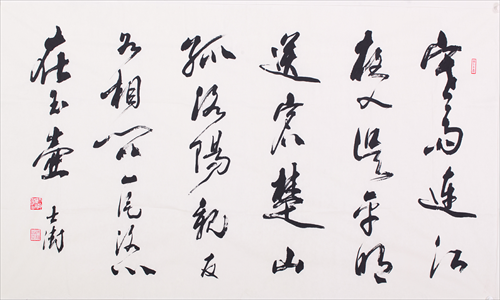
A work by Tang Dynasty (618-907) poet Wang Changling
The importance of literature to calligraphySu has held several calligraphy exhibitions in recent years, many of which featured literary themes, like "Reading Encourages People," "The Scholar's Four Jewels," "Engraving Prefaces and Postscripts" and so on.
More than just calligraphy, his works feature elements of poetry, traditional culture and civilization studies. It is no wonder some people say that seeing his calligraphy exhibitions is like reading a good book. For Su, calligraphy is like writing a book. When audiences approach his works with a literary mindset, they are able to appreciate their spiritual resonance. After all, books are Su's best friend, and even his engraving works are rich with literary charm.
Since the ancient times, both scholars and calligraphers have drawn intellectual sustenance from reading books. Being able to paint beautiful Chinese characters is just the foundation for success in calligraphy. For masters like Su, knowledge and experiences outside the writing brush and paper are important. Over his decades of study and research, as well as learning from masters like Qi and Liu, Su has never given up reading, and sees reading and calligraphy as one.
As a result, Su frequently organizes all kinds of seminars and invites his peers in the art industry from both home and abroad to communicate with him. He sees every artist as a book and never misses a chance to draw wisdom from one.
What calligraphers ought to write about is a hot topic among Su and his friends. He thinks that modern calligraphers should not copy ancient poetry, but rather write their own original works. But many calligraphers say they dare not do this, in case their work is not good enough and is laughed at by audiences. Su answers that, by reading, they too can become master writers.
Compared with these peers, Su has already published many poetry and prose works, many of which have been well received in the market.
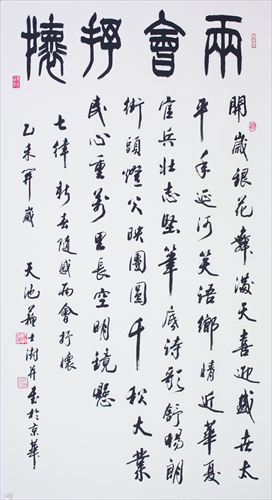
Su Shishu's poem "Liang Hui Shu Huai"
The mission of a scholarAlthough Su has many honorary titles, such as president of the China Collector of Penmanship and Painting Association and chairman of the China Government Calligraphers and Painters Association, he still makes time for doing his own art every day.
In 2014 Su organized a calligraphy and painting exhibition in honor of the 110th anniversary of Deng Xiaoping's birth.
The exhibition was held in different cities across China, including Beijing, Qinhuangdao in Hebei Province, and Shenzhen, Zhuhai and Foshan in Guangdong Province. The exhibition saw an especially warm welcome in Shenzhen, which was the first place to benefit from Deng's reform and opening up policy in the 1980s.
The exhibition featured 100 paragraphs of Deng's literary work, which 100 calligraphers rendered in different styles. It also included 10 paintings, including a portrait of Deng as well as exquisite Chinese landscapes.
As a calligrapher, Su has never forgotten his mission, nor his identity as a scholar. He believes that it is every person's obligation to sacrifice him or herself for the glory of the nation, rather than work for their own small benefit. "We must leave something valuable for future generations," he said.
Although Su is over 60, he is still active in creating art. He is a case in point that, no matter what their achievements, truly great men have the capacity to remain modest forever.
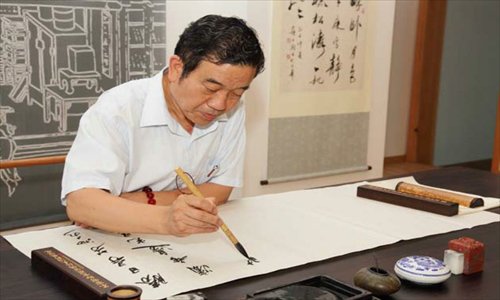
Su Shishu
Introduction to the artistSu Shishu was born in 1949 in Beijing. A master of calligraphy and engraving, he learned from many famous masters such as Liu Boqin and Qi Gong. His calligraphy work, which features a strong personal style and an integration of Qin and Han dynasty (221BC-AD220) characteristics, is famous for its use of the dazhuan style and the jihao inkbrush.
Su has been an editor of ancient calligraphy copybooks and calligraphy textbooks at the Cultural Relics Press for more than 30 years and has won the Taofen Award, the highest national award for an editor, due to his achievement in editing calligraphy related books.
He is now a member of the Standing Committee of the CPPCC, the deputy president of the China Calligraphers Association, the head of the China Collector of Penmanship and Painting Association, and a professor at the China Calligraphy Training Center.
Su has held exhibitions of his calligraphy, engraving and painting work in the Chinese mainland, Taiwan and Japan. He's also devoted to charity, and has donated works worth millions to people in Yushu county in Gansu Province since the earthquake in 2010
